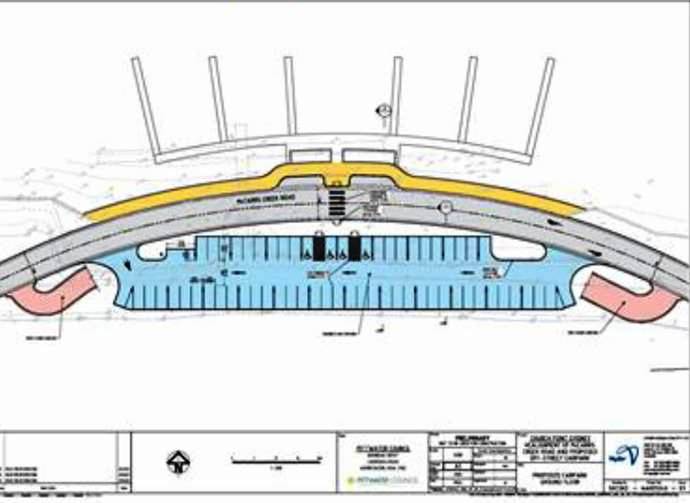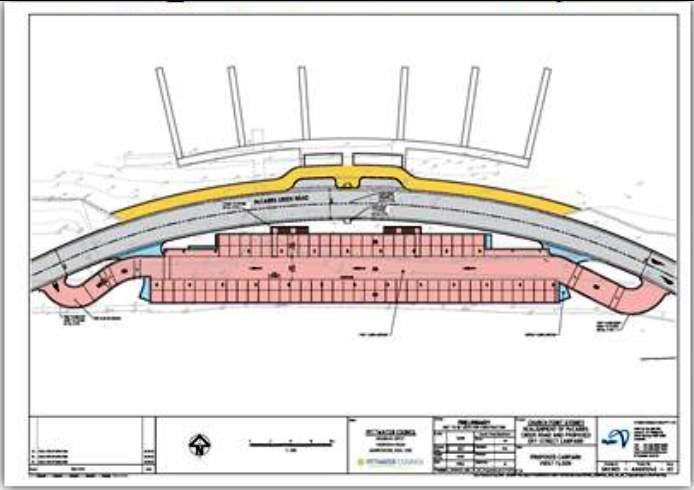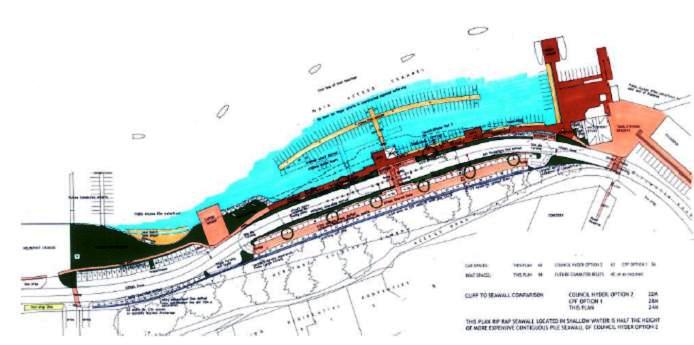December 8 - 14, 2013: Issue 140
What’s the Point?
What’s the Point?
CP stands for Church Point, not Car Point – Save CHURCH POINT!
“They paved paradise and put up a parking lot!”
In Pittwater Rising, a book about the formation of our Council, Pittwater is described as ‘a beautiful and affluent part of Sydney, [having] a striking, diverse and fragile environment’. Aside from the ‘fragile environment’ we all chose to live here for; the environment, the natural beauty, the beaches and shores. The Council’s logo in fact is a mangrove tree surrounded by water representing the rugged National Parks and suburban areas surrounded by the estuaries, bays and bushland – and their mission is “to be leaders in the provision of Local Government Services, to strive for sustainability through conservation, the protection and enhancement of the natural and built environment of Pittwater and to improve the quality of life for our Community and for future generations."
Well I am the future generation! I’m a 25 year old Pittwater woman and feel that I, being a ‘youth’, a ‘Gen Y’, a ‘Gen Now’… whatever you would like to label me, need to stand up and speak against Pittwater Council’s proposed excessive parking structures near Church Point Wharf. I feel driven to this as the parking structures do not improve the quality of life for our Community or future generations and
do not conserve, protect or enhance the natural environment of Pittwater – which I love!
So then, what is the real problem – off-shore residents that use Church Point to commute to their homes do not have enough car spaces to park their cars (Summer being far worse than Winter) and visitors are attracted by the natural beauty and spirit of Church Point. Residents have to compete with an ever-increasing number of visitors which has increased due to a combination of the extended Waterfront Store/Cafe; more yachts moored nearby and more offshore overnight venues. The Pasadena Development Consent will most likely cater for at least 140 patrons based on existing rights but according to Council could have a capacity of over 400.
This problem has been going on for many years, nearly 30 years in fact, (yes, older than me!) and the Council have proposed two options; a 60 car ground level option (Option 1) or a 120 car space decked car park (Option 2) The Church Point Friends Group (a group of like-minded on- and off- shore residents) has proposed a third 40 - 60 car ground level option (Option 3), depending on the parameters Council chooses.



In 2009 a Plan of Management (PoM) was adopted for the Church Point Area based on the premise that failing to adopt the Plan would lose access to Government funding for the Commuter Wharf and that design details would be developed with the community. It was not accepted by all on- and off- shore residents. Two key objectives of the PoM are to ‘recognise and provide for local resident issues, developing management strategies consistent with community values and expectations’ and to ‘resolve management issues with a ‘triple bottom line’ approach – economic, environmental and social values’ however it appears that these matters are being brushed aside. This is an expensive solution with ongoing costs, an environmental disaster and is socially dividing the community!
Do the current proposals meet the mission statement of the Council? Do the current proposals fix the problems? Does the current proposal meet the PoM objectives? Or the triple bottom line approach –
economic, environmental or social values?
1. Economic
Parking Demand Management has not be researched, tested, and trialled and agreed upon
Building more car parking spaces will create more demand for car spaces as it attracts more visitors and increases the likelihood of offshore residents to own more cars. A demand management profile has not been conducted on Church Point so we do not know how many car spaces we need now or in the future, all we know is that we need some more. The axiom of, ‘if you build roads, cars come’ also
applies to parking. Church Point has natural limits. By ignoring these limits you ignore the character and quality of the environment.
In the future, there will be an increase in visitors, businesses, residents, B&B’s, off-shore holiday lettings and a growing number of moored boats - all of which needs to be taken into consideration. Additional demand management strategies have to be considered hand in hand with all options and it is vital that the needs of offshore residents and visitors are seen separately. The current options are
short-sighted and only a very small part of the solution to the problem. Other options have not yet been considered for example; shuttle buses, additional ferry routes, the use of bicycles, improvement of the bus timetables, pricing differentiation for first and second household Permits or dispersed car parking. These options have not been comprehensively reviewed and costed and have not been
projected against the demand for parking now and in the future.
The current focus is on how to manage offshore demands rather than visitor demands which is seasonal. To alleviate these conflicting demands, perhaps visitors can be accommodated at in and around Rowland Reserve using a shuttle bus to access Church Point together with providing Church Point permit holders with priority during the evenings.
The proposals are not based on facts (e.g. limited geotechnical studies) and therefore costs are estimates only and therefore there is a risk of cost blowouts.
A civil engineer who informally reviewed the Hyder Report stated that the report was inconclusive due to the uncertainty of geotechnical reporting and this was an early concern to the project, surrounding areas and properties and could result in unforeseen issues to surrounding areas through construction and unforseen costs. There is great uncertainty surrounding the nature and location of a bedrock
stratum that will support the concrete piled walls.
So what this means is we don’t know enough about the environment that we are building the infrastructure on or around, we don’t know the amount of infill into Pittwater, (some of which will be left in Pittwater), we don’t know the risks and we don’t know the real costs!
2. Environmental
The proposals do not conserve, protect or enhance the natural environment of Pittwater
The PoM is more than just a plan for car parking and development. It is also a plan for our environment. The plan for car parking has been prioritised ahead of conserving the natural environment. A Review of Environment Factors (REF) and Part V Assessment have not been conducted on the proposals and will be done so after the decision has been made! Also, the DPI Fisheries normal response to an infill of this extent (we do not know the amount of tonnes of infill into Pittwater) is to ‘not approve infill works under any circumstances’. How does a car park fit into this?
Should not the environmental impact be taken into consideration before the decision is made so that it aligns with the triple bottom approach?
Precinct One is described as an ‘eye sore’ in the Hyder Report (the firm who designed the solutions);
the visual impact drawings are deceptive as the 2-dimensional studies do not express the three dimensional reality the massive decked proposal will have and there has been no independent visual impact studies conducted. Which is the eyesore - a vegetated backdrop with Spotted Gums that currently exists or a concrete carpark? What is Church Point is going to look like after it is built? The concrete deck second level goes over the current road and the road goes out into the bay and deep water. Will it still look like Church Point? Will it still feel like Church Point? The amount of infill will push the seawall so far out that future extensions to the commuter wharf are planned to extend further into Pittwater rather than providing boat tie ups in the protected landward side of the pontoon. So the snowball gets bigger and bigger....
AND McCarrs Creek Road is listed on Pittwater’s Most Scenic Street Register which was created at the request of Council to more effectively manage the preservation of the natural and cultural features of Pittwater’s public roads and to ensure future developments enhance the identified qualities. It says ‘… McCarrs Creek Road follows the shore of Pittwater Estuary with an ever changing kaleidoscope of water, parks, mangroves, sand flats, off-shore houses, marinas, wharves, boats of all shapes and sizes and types - including workboats and the Church Point ferry’… And a decked concrete monstrosity?!
Does the car park structure adhere to the Pittwater Streetscape Management Policy?
The natural beauty and environment will be destroyed forever and the proposal is unacceptable to the broader community.
Once a decked car park or any car park is built it cannot be removed! Now, I’m not sure where you will be in 20, 30 or 40 years but I plan to still be here! I plan to still be in Pittwater! It is already so difficult to find the natural shore of Church Point, but its traces are there.
Option 3, proposed by the Church Point Friends Group, attempted to demonstrate that there are other ways of approaching the problem – all to no avail! Their focus was to keep engineering and development to a minimum whilst still providing at least 50 car spaces accommodating a normal 85th percentile vehicle size. When parking is only for the offshore residents it is usually low turnover and long stay. The off-road parking cell suggested by Church Point Friends Group allowed for less infill as the new road follows the line of the cliff and water edge minimising the engineering overdevelopment with a curved road. It is the only option that separated pedestrians from cars similar to the planting of the Bayview foreshore walk. If Option 3 is adopted with a reduced speed limit or traffic calming and shared high pedestrian zone, the natural beauty and environment can be at least somewhat preserved and also not be an attraction for late night car and motorbike enthusiasts.
The proposals have brought about hostility and division into the heart of the community as the proposals are not acceptable to the majority. Onshore residents are hosting parking for offshore residents, but have no say about what is built on their front doorstep. I do feel sorry for the offshore residents; they were promised that new spaces funded by their parking sticker contribution would be just for them. Some offshore residents may not be able to afford a permit or leased car space resulting in a daily divide, and some may still not want to pay anything for parking and continue to park in the streets! Imagine how divisive it will be if you need to park and there are empty spaces which you cannot access yet visitors who could have been serviced by a shuttle bus are taking up all other car spots and Church Point streets are still filled with cars!
3. Social
The proposals do not improve the quality of life for our community or future generations
Our community: about 32% off all offshore households from the lower Western Foreshore and Scotland Island (who rely upon ferry/boat access to their homes) indicated a preference for a 2 storey
car parking structure along the Church Point waterfront. That’s about 0.3% of all Pittwater households. What about the remaining 99.7% of Pittwater?
What this survey, conducted exclusively by and for off-shore residents, showed was that they want to maximise available car parking and, in the absence of any other option to choose from, they voted for a two-storey car park. The Council have stated that this facility will be available to visitors through pay and display and to offshore permit holders. There is no guarantee offshore residents will have exclusive use during peak times or priority over visitors! So it is understandable that offshore residents would vote for this option!
What is highly likely is that this development will drive more visitor parking demand and thus continue the practice of ‘cruising’ the car parks, adjoining streets and along McCarrs Creek Road.
Onshore residents will have to deal with a physically degraded waterfront with increased noise and traffic, more car alarms, obtrusive lights, reduced privacy and peace, glare from concrete and windscreens, devaluation of their homes and affected views so that offshore residents and visitors can park their cars!
The outcome of the Pasadena DA is unknown
The outcome of the DA for the Pasadena redevelopment at Church Point is yet to be determined with parking being a major issue and the bulk and height of the proposed building and its impact on the character of Church Point. If either of the Council Options is approved, it will only reinforce the applicant’s case that sufficient public parking will be available at Church Point in the near future.
More cars! More cars!
The Council meets again on 16th December 2013 to make a final decision and I encourage you to email the councillors and Pittwater Council at: Pittwater_council@pittwater.nsw.gov.au with your comments and concerns in regards to options being presented. I know and understand that something must be done but an engineering sledgehammer which may be redundant in decades to come is not the answer!!
I call on the Councillors to reject the excessive parking structures and to look outside the box at other options. Nearly 300 supporters have signed a petition (https://www.change.org/en-AU/petitions/pittwater-council-fixour-problem) urging the Council to Fix Our Problem and design something that is acceptable to both on- and off- shore communities whilst maintaining, conserving and protecting the natural beauty and environment of Church Point and also meeting the triple bottom line.
Is a waterfront car park the legacy that should be left behind for future generations? Is a waterfront car park the legacy Councillors want to be remembered for? Providing extra car parking alone will never solve the problem at Church Point, but it can blight its beauty forever. Please Council do not build a car park on our striking, diverse and fragile environment! Church Point is full!
Building a car park in Church Point – What’s the Point?
Tarryn Priestly – Pittwater Resident
Article by Tarryn Priestly, 2013.
